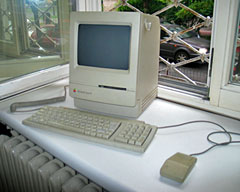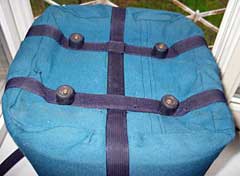Jacek A. Rochacki is a member of the Polish Pismo Owner's Club in
Warsaw.
Years ago, when I was using happily my Mac SE with two FDD 800 KB drives and an
external SCSI 80 MB hard drive, life had changed in a good
direction. I was nominated to became a visiting teacher in a
certain Western European country, which involved taking up to six
trips abroad per year, and it was a great help to have my computer
with me as one of the instruments for playing the clever man.
The nature of my educational service required having about 100
kg of instruments, rare printed materials and books, and plenty of
tools, so air travel was out of the question. My first Toyota
provided me with very reliable service; my books and tools were
ready for transportation. The remaining question was the computer
system, especially the external hard drive, which didn't make the
Mac SE an easy thing to transport.

The author's Mac Classic II.
The PowerBook 100 was then far too
expensive for me, so I went for a second-hand Mac Classic II, mostly due to it's
internal hard drive. I still keep this machine in perfect working
condition, and it nicely amazes the children and grandchildren of
my friends.
The question of transportation for the Classic II boiled
down to designing and making a proper bag; such bags were available
in USA, but I had no time to get my US residing friends involved.
The designing was very simple, as the cuboid form of the computer
determined the shape of the bag.
In order to do the job properly, I began by obtaining the best
materials (in my opinion). I used rugged Cordura® for the outer
shell, which I got from my colleague, who was then running small
company specializing in making rucksacks.
 I
sewed the inner lining of fleece, like the one used for outdoor
activities garments, and stiffened the sides with pieces of
carrimate, cut accordingly to the desired shape and fixed invisibly
between the outer and inner lining of this bag. In this way I also
made side compartments for the keyboard and some other gear.
I
sewed the inner lining of fleece, like the one used for outdoor
activities garments, and stiffened the sides with pieces of
carrimate, cut accordingly to the desired shape and fixed invisibly
between the outer and inner lining of this bag. In this way I also
made side compartments for the keyboard and some other gear.
I took special care with the bottom of my bag. In order to make
it stiff and solid enough, I cut a piece from 1 cm. thick Kevlar
plate, and used it as a sort of foundation in the bottom. Then I
fixed with solid screws four rubber elements, which were simple
rubber stoppers that were those days used in home interiors for
preventing doors from contacting walls.
And here is my first mobile computer in
this bag, ready for the road.
 When in
due time St. Peter calls me to His gates, if I were given a choice
which machine to take with me to continue writing, I would be in
difficult situation. I respect the speed and power of my Little Al PowerBook, I admire the close
to perfectness quality of Pismo,
and I enjoy the ruggedness of my Wallstreet II. But I can not exclude,
that I would then pack once more my Mac Classic II into its
carrying bag . . . it has been so good on long journeys.
When in
due time St. Peter calls me to His gates, if I were given a choice
which machine to take with me to continue writing, I would be in
difficult situation. I respect the speed and power of my Little Al PowerBook, I admire the close
to perfectness quality of Pismo,
and I enjoy the ruggedness of my Wallstreet II. But I can not exclude,
that I would then pack once more my Mac Classic II into its
carrying bag . . . it has been so good on long journeys.


 I
sewed the inner lining of fleece, like the one used for outdoor
activities garments, and stiffened the sides with pieces of
carrimate, cut accordingly to the desired shape and fixed invisibly
between the outer and inner lining of this bag. In this way I also
made side compartments for the keyboard and some other gear.
I
sewed the inner lining of fleece, like the one used for outdoor
activities garments, and stiffened the sides with pieces of
carrimate, cut accordingly to the desired shape and fixed invisibly
between the outer and inner lining of this bag. In this way I also
made side compartments for the keyboard and some other gear. When in
due time St. Peter calls me to His gates, if I were given a choice
which machine to take with me to continue writing, I would be in
difficult situation. I respect the speed and power of my
When in
due time St. Peter calls me to His gates, if I were given a choice
which machine to take with me to continue writing, I would be in
difficult situation. I respect the speed and power of my 
